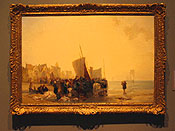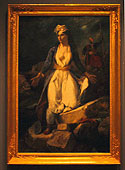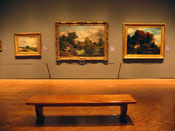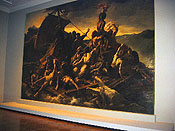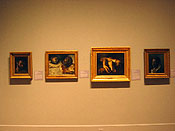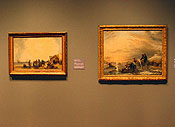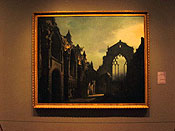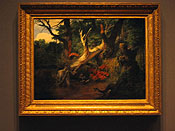The browser will either open the file, download it, or display a dialog.
|
"Constable to Delacroix: British Art and the French Romantics" Patrick Noon, with contributions by Stephen Bann, David Blayney Brown, Rachel |
||||||||
|
This ambitious exhibition (fig. 1) traces the affinities between British and French painting from about 1815, when the French monarchy was restored, to 1837, when Queen Victoria came to the throne. The emphasis, as the title indicates, is on how knowledge and acceptance of British art of this period became a cardinal force in the development of romantic painting on both sides of the Channel, particularly in the 1820s. (In Minneapolis and New York, the exhibition was entitled "Crossing the Channel.") The subject suggests remarkable possibilities that have never been explored in an exhibition; the present show reunites works of art that artists, critics, and the public in these rival nations saw, studied, and were inspired by. The idea that British art was in fact radically separate from French ideals is not new, nor is it disputed among nineteenth-century scholars except in France, where there is still some reluctance to credit the British with a role in the development of romantic painting. Where there is French acknowledgement of a British contribution, it is often situated in literature, with Scott and Byron taking leading roles as weavers of intense dramas for French brushes. |
|||||||
| Organized by Patrick Noon, the exhibition is a bold attempt at presenting concurrent dialogues that helped forge the character of painting in the two capitals of art in the first half of the nineteenth century. At the Tate, the works were hung in dramatic style on walls painted in different tones of gray, purple, and olive—an arrangement that takes some getting used to and ultimately did not always show the paintings in the best light. But most relevant is the juxtaposition of specific British and French pictures, some of which were expected, while others came as a surprise. In the first room, for example, Eugène Delacroix's and Thales Fielding's respective portraits of each other—made when both shared a studio in 1823—were placed side by side to striking effect, thereby setting the stage for the intermingling of approaches. In the same room, Richard Parkes Bonington's luminous Fishmarket Near Boulogne (fig. 2) was next to Delacroix's dark Greece on the Ruins of Missolonghi, painted two years later (fig. 3). Although most visitors would be aware of the Bonington-Delacroix connection, and hence the reason for their proximity, it came as a jolt to see them together because of the visual dissimilarity in subject, style, and technique. They indeed demonstrate two aspects of romantic painting: one, its concentration on natural effect, a British strength; the other, its focus on topical events, presented in a realist-allegorical mixture. However, due to the jarring contrast presented by this particular juxtaposition, it was difficult for the non-specialist to make comparative judgments. Indeed, throughout the show, there is a presumption that the viewer will make certain connections or will understand the context. For this reason, while most catalogues are to be read after the exhibition experience, reading this catalogue beforehand is imperative. | ||||||||
|
As has been pointed out many times, the revelation of British artistic achievement came ostensibly during the Salons of 1824 and 1827, when the French saw the works of John Constable. Constable's fame rose considerably after this, as a recent exhibition in Paris devoted to the artist underscored brilliantly. His View of the River Stour at Dedham, which accompanied the more celebrated Hay Wain (which was not lent by the National Gallery) to the Salon of 1824, is an example of the kind of work that spurred French artists to a freer landscape style, as indeed did The White Horse shown in Lille the following year (fig. 4). But while the point is easily made in the sphere of Constable, it is not always evident elsewhere. Why show Turner's very Claudian landscape Crossing the Brook of 1815, which seemed particularly out of place, unless it was to illustrate the more classically picturesque side of Turner that the French preferred? Similar examples by Camille Corot, Achille-Etna Michallon, Jules Dupré, Horace Vernet, Théodore Rousseau, Jacques Raymond Brascassat, and others seem stretched on the French side, as it was not readily clear to the viewer what connection should be made. Some of these painters were already moving toward a freer expression in their own rejection of French academic principles and had no need of British stimulus. The case of Paul Huet, with whom Bonington traveled, is somewhat different in that specific connections can be made, but these were not easily seen in all of the exhibited works. | |||||||
| The emphasis of the exhibition rests mostly on the axis of Géricault and Delacroix in France and Bonington and Constable in Britain. The impact of Géricault is a principal theme of the exhibition, which includes thirteen of his paintings, three lithographs, two wash drawings, and two watercolors, but not the key work, The Raft of the Medusa, which cannot leave its permanent berth in the Louvre. To emphasize its importance in Britain after its showing in London in June 1820, the organizers hung, in a separate room meant to provide an idea of its original London setting, a full-scale copy by Guillemet and Ronjat painted forty years later (fig. 5). It seemed unnecessary, indeed unduly indulgent, to exhibit the copy, since everyone interested in the subject of the exhibition knows Géricault's monumental canvas intimately. Nevertheless, the show included a variety of his studies for the painting, most of which were already displayed in the 1992 retrospective, where, parenthetically, Gèricault's London visit was well documented (fig. 6). Yet, seeing these ghastly severed heads and butchered limbs again reminds us how shocking such paintings were and how emotional the impact was on contemporary viewers. Few of the British works included in the exhibition came close to imparting the same force. J.M.W. Turner's A Disaster at Sea is a logical choice to pair with the Raft, given its subject, prominent diagonal composition, ebullient color, and palpable energy, but the relationship seems superficial, particularly since Turner, whose anti-French sentiments were well known, was moving in a very different pictorial direction. Haughton's engraving of Henry Fuseli's Ugolino of 1809, which Géricault certainly knew, was used to illustrate the common theme of cannibalism, but this connection also seemed weak. And why show Leon Cogniet's A Woman from the Land Eskimos of 1826 (seen only in the American venues) at all, since it does not relate to the theme of Géricault's influence? | ||||||||
|
|
||||||||
| Some works in the exhibition that were highly regarded in their day now seem especially tame and spiritless. Sir Thomas Lawrence's Master Lambton, shown in Paris in 1827, is an example. Delacroix told Baron Schwiter, whose portrait is included in the show, that it was one of the sensations of the year and that a print of it could be seen in all of the Parisian dealers' shops. It is true that most critics praised it highly, even though Stendhal, an Anglophile himself, reiterated French opinion that Lawrence "dessine d'une manière ridicule." The portrait was exhibited in France again in 1855, when Théophile Gautier praised it, and then in Manchester in 1857, when Théophile Silvestre thought it remarkable. On seeing this picture, Prosper Mérimée went so far as to exclaim "on pouvait être Anglais et artiste." However, looking at it today, one can only wonder from where such praise came, especially since Lawrence's talents were not always so appreciated by the French. For example, in 1824, the artist's portrait of the Duc de Richelieu was castigated by Fabien Pillet, who asked "Où est l'ecolier de dix ans qui ne peindrait pas mieux des bras et des épaules?" | ||||||||
| Lawrence's picture reminds us that taste fluctuates, so that certain paintings, perhaps useful in illustrating the idea of the exhibition, do not appear significant as works of art in themselves today. Looking at such canvases as William Collins's Frost Scene, or Sawrey Gilpin's Horses in a Thunderstorm, or Alfred de Dreux's Intruder, or William Etty's Phaedria and Cymochles, or Pierre-Henri Révoil's René of Anjou, or Sir Edwin Landseer's Cat's Paw, among others, it is difficult to ignore their respective weaknesses. The catalogue gives little reason for the inclusion of Collins's picture (fig. 7); Gilpin's painting of 1797–98 is justified since it would have been known by Gericault and Delacroix, who made a watercolor copy of the horse; De Dreux's canvas is presented as analogous in spirit to Gericault's and Delacroix's horse pictures, although it is far inferior to both; Etty's painting, taken from Spencer, was said to have "astounded his French peers" (p. 138), and was supposed to have anticipated some of Delacroix's Algerian scenes, but little of this is visible; and so on and so forth. | ||||||||
| Aside from these questionable examples, many of the 190 works in the exhibition are indeed of interest. The star is certainly Bonington, whose ten paintings and four watercolors are exceptional. No modern scholar knows Bonington more intimately than Noon, who selected brilliant examples to show in London, all the more important as his 1991–92 Bonington retrospective was shamefully absent from British museums. (In this connection it is worth noting that the Wallace Collection, which does not lend, is simultaneously holding a small exhibition of thirty works by the artist, accompanied by a handsome catalogue by Stephen Duffy.) Besides the array of Boningtons and the first-rate Constables, feast enough for the eye, there are many paintings of note that have rarely been shown publicly. Louis-Jacques-Mandé Daguerre's The Chapel of Holyrood is a tour de force (fig. 8); Alexandre-Marie Colin's The Giaour is as riveting as Delacroix's essays on the subject; James Ward's study for The Boa Serpent is as terrifying as Gericault's Raft studies, and remarkably alive; Camille Roqueplan's The Antiquary, after Scott's favorite Waverley novel, is literary romanticism in microcosm and has not been exhibited outside of the Chi Mei Museum, Taiwan; Horace Vernet's Hunting in the Pontine Marshes, a rare landscape study by the master, looks neither French nor British, but oddly American (fig. 9); Turner's Calais Sands, Low Water dazzles the eye with its blazing sunset; Jules Joyant's San Giorgio Maggiore, by this Bonington student, reproduces his master's éclat without losing his own artistic personality; or any of the works of the underrated John Frederick Lewis, whose paintings stand out by virtue of their gleaming color and assured drawing. | ||||||||
| The catalogue contains a major essay by Patrick Noon on Anglo-French interchanges of the period, a succinct and vital introduction to the subject. Stephen Bann contributed a chapter on the importance of prints in the genres of voyage views, illustrations of Byron's Mazeppa, and the reproductions of Delaroche's scenes. There are some niggling errors here (the Peace of Amiens was in 1802, not 1803), but the essay is informative, even if it reads like a lecture. David Blayney Brown wrote several short introductions on Anglo-French contacts, on Shakespeare, Scott, Byron, and genre, and on the painting of modern life, including portraiture, while Christine Riding summarized the showing and impact of the Raft in England. There is also a short introduction by Noon on the nature of exhibitions on both sides of the Channel, on landscape painting in France and Britain, as well as on the ascendancy of watercolor in both countries. The latter section, incidentally, is a very successful expression of the idea of the exhibition, with remarkable examples by Louis Francia, Paul Huet, Thomas Shotter Boys, William Callow, William Wyld, and a superb Isabey. | ||||||||
| The catalogue adds to the growing literature on the cross-cultural artistic influences between France and England, as did the symposium held at the Tate on 22–23 March 2003 in conjunction with the exhibition, entitled "The French Affair with British Art," where sixteen scholars, of which only one was French, offered views based on their different specialties. But in the end, the nagging question remains why this fertile subject was explored in an exhibition format. Since many major works known to have played a significant role in the interchange between the two nations could not be lent, specialists and the public might have been better served if the research had gone into a scholarly text where the availability of works for loan, considerations of space, and other restrictions need not have hampered the project. | ||||||||
| William Hauptman Independent Scholar Lausanne, Switzerland |
||||||||



